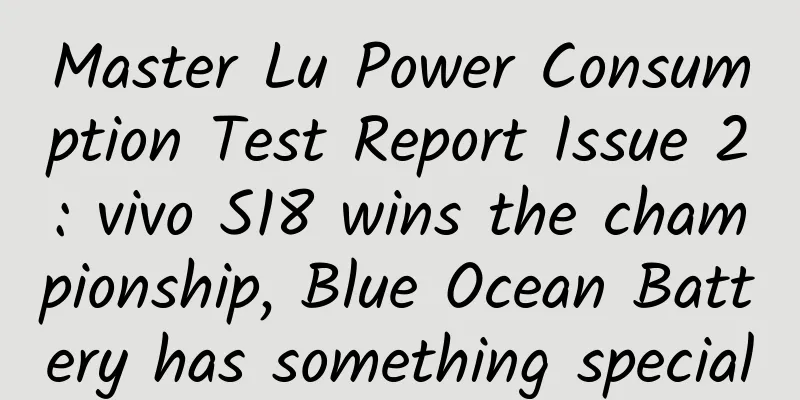Master Lu Power Consumption Test Report Issue 2: vivo S18 wins the championship, Blue Ocean Battery has something special

|
As the year draws to a close, those friends who have held back on changing their phones for a whole year are probably starting to feel the urge to buy a new phone as they see the year-end bonus and New Year approaching. However, facing the new phones that are coming out one after another, many friends are once again in a dilemma of choice. To me, no matter how fancy the functions are, "battery life" is always the basic experience of a mobile phone. Frequent charging is not only annoying, but also unfriendly to "working people". Based on this, Master Lu Laboratory officially released the "Mobile Phone Power Consumption Evaluation Standards", and based on this set of standards, announced the test results of the first phase of "Mobile Phone Power Consumption Test". The power consumption of a mobile phone, in addition to the load of the CPU and related hardware, the capacity of the battery itself is the "underlying foundation" that determines the lower limit of the phone's battery life, while the system scheduling and related optimizations are the "superstructure" that determines the upper limit of the phone's battery life. The two complement each other and are indispensable. The development of smartphones in terms of battery life can be described as two flowers blooming in the field of battery and optimization. Battery technology has made breakthroughs in charge pumps, multi-core technology, battery materials, etc., not to mention system optimization. AI has been involved early on, and the optimization for various usage scenarios is also meticulous. So in this context, will the battery life performance of these new phones see another breakthrough by the end of the year, and what will their battery life performance be like? Don’t worry, the second issue of “Mobile Phone Power Consumption Test” from Master Lu Laboratory is here! Test Introduction For this 8-hour battery life and power consumption test, Master Lu's laboratory selected mainstream flagship products from major manufacturers with a price range of 2,500 to 3,500 yuan at the end of the year. The test scenario maintained the same brightness, network, volume, and display settings for all mobile phones. At the same time, the game used an extremely high frame rate and maximum image quality. The models involved in the test are: Redmi K70 Pro equipped with the latest Snapdragon 8 Gen3 processor and a 5000mAh battery; Meizu 21, also a Snapdragon 8 Gen3 terminal with a 4800mAh battery; Honor 100 Pro equipped with Snapdragon 8 Gen2, with a 5000mAh battery and Xiaomi 13 with a 4800mAh battery; the sub-flagship part chose OPPO Reno11 Pro equipped with Snapdragon 8+, and vivo S18 equipped with Snapdragon 7 Gen3, which have battery capacities of 4700mAh and 5000mAh respectively. It can be seen that taking the flagship Xiaomi 13 a year ago as a benchmark, after a year of development, the battery capacity of mobile phones has generally ushered in another increase, exceeding 4500mAh. Models like Redmi K70 Pro, Honor 100 Pro and vivo S18 have all reached a larger capacity of 5000mAh. At the same time, Master Lu's laboratory has also made further design optimizations for the simulation scenarios of power consumption testing. This power consumption test will include nine high-frequency scenarios of mobile phone use in daily life, including social networking, short video, news browsing, e-books, long videos, map navigation, games, shopping, and video calls; The test will run applications such as WeChat, QQ Music, Tik Tok, Toutiao, Qimao Novels, Bilibili, Amap, Honor of Kings, and Taobao. After the full 8-hour test process, the remaining power will be used to determine which phone has a longer theoretical battery life. Before the test officially begins, all phones will be set to turn off the smart charging mode to ensure that they can be charged to 100%. At the same time, they will continue to charge for 20 minutes after charging to 100% to ensure that the battery completely stops trickle charging. Kill all background apps and leave no apps; adjust the backlight to manual backlight, and manually set the screen brightness to 120nit brightness, smart refresh rate, and smart resolution based on a pure white picture in the gallery. During the test, the volume of the mobile phone will be set to +7 levels from the minimum volume. In addition to simulating outdoor navigation scenarios, the network environment is connected to WiFi. When simulating outdoor navigation scenarios, the cellular network data provided by the mobile 5G mobile phone card is connected. In both network scenarios, the mobile phone will turn off the automatic update of the application market. The entire testing process is completed in a laboratory environment. All operations involving sliding are performed by robotic arms, simulating all variables as objective controllable factors to ensure the accuracy and credibility of the final results. Test Results OK, after introducing the preparations, we officially entered the testing phase. The first test was the WeChat social scene, which lasted 70 minutes. During the test, we opened WeChat on 6 mobile phones at the same time, clicked on the chat window every 20 seconds, and swiped through the Moments every 20 seconds. At the same time, QQ Music was running in the background to play local music files. At the end of the test, it can be seen from the power consumption of each machine in this stage that the social scene is a relatively light-load operating scenario. Among the six mobile phones, only the Meizu 21 had an abnormal power loss, consuming 11%. The other five mobile phones only consumed about 3%-4% of power, which also laid the groundwork for the final result. After that, the test phase of Douyin short video will begin. This process will last for a total of 3 hours and 20 minutes. During the test, each video will be played for 30 seconds. After 30 seconds of playing, swipe up to switch to the next video. The test at this stage is a relatively overloaded environment. First of all, the act of watching short videos is a process that requires frequent downloading and caching. The power consumption of uplink and downlink exchanges on the network is not small. At the same time, changes such as sliding the screen and sound will also be more frequent, and the test time will be longer. Therefore, we can see that the battery power of the six mobile phones has dropped significantly. However, what is quite eye-catching is the battery life performance of vivo S18. While the power consumption of the other five mobile phones exceeded 20%, it controlled the power consumption in this stage to 17%, making it the least power consuming among the six mobile phones. In the following five scenarios, namely news browsing, e-book reading, long video watching and simulated map navigation, it can be seen that the six mobile phones are not too stressed, and the power consumption of a single item does not exceed 5%. Next is the highlight of the test, the game test. We chose the game "Honor of Kings" as the test material, and all 6 mobile phones watched the "God Watch" in the game for 50 minutes under the settings of "Image quality: very high; Frame rate: very high; Anti-aliasing: on". This is a relatively heavy-loaded scene after the "short video test", and it is very demanding on the CPU's performance and energy efficiency. From the final results, it is not difficult to see that the six mobile phones have ushered in the second wave of power consumption peak, and the power consumption has exceeded double digits. Among them, Honor 100 Pro and Xiaomi 13 have the highest power consumption, both of which have lost more than 20% of their power; and the least is still vivo S18, which only lost 15%. In the last two activities, Taobao shopping and WeChat video calls, the six phones did not lose much power during the test phase, which was relatively a light load scenario. So, from the abnormal WeChat power loss at the beginning to the two peak power consumption of short videos and games, there is actually not much suspense about how much power the six phones will have left in the end. After 8 hours of simulated battery life test, the final ranking of "Master Lu Mobile Phone Power Consumption Test Phase 2" is as follows: 1. The remaining power of vivo S18 5000mAh in Master Lu's battery life test is 43%; 2. Redmi K70 Pro 5000mAh Master Lu's battery life test shows the remaining power is 32%; 3. Honor 100 Pro 5000mAh Master Lu's battery life test shows that the remaining power is 31%; 4. OPPO Reno11 Pro 4700mAh Master Lu's battery life test shows that the remaining power is 31%; 5. Xiaomi 13 4500mAh Master Lu battery life test: remaining power is 25%; 6. Meizu 21 4800mAh Master Lu battery life test shows the remaining power is 22%; The vivo S18, which was released the latest, won the championship of "Master Lu's Mobile Phone Power Consumption Test Phase II" with 43% remaining power. The reason for its victory is not difficult to find. First of all, the battery capacity of vivo S18 itself is very large, as high as 5000mAh, and secondly, the battery itself. The vivo S18 is equipped with an ultra-thin "blue ocean battery". It is reported that this is a product jointly developed by vivo and the industry's leading lithium battery company. While reducing the volume, the battery density is increased, which brings a super large battery capacity to the vivo S18, while keeping the thickness of the phone at only 7.45mm! It perfectly balances the large-capacity battery and the light and thin feel. In addition, vivo's self-developed blue ocean endurance system has more than 100 power-saving optimizations, which comprehensively improves the battery life. It has large capacity, fast charging, and light size. At the same time, the battery life has also been significantly improved. The vivo S18's Blue Ocean battery can be used for up to four years. The longer battery life plus the more durable battery make the phone more durable and easy to use! Of course, it’s not just the vivo S18. In Xiaomi 13, we also see that it has surpassed the battery life of Meizu 21 despite its relatively backward battery capacity through excellent system scheduling and optimization. The "abnormal performance" of Meizu 21 during the WeChat testing phase also indirectly shows that its system still has room for further optimization. Finally, the Snapdragon 7 Gen3, a new member of the Snapdragon 7 series, also helps the vivo S18 to achieve excellent energy efficiency control while releasing certain performance. This chip is built based on TSMC's 4nm process. The CPU consists of 1 2.63GHz core, 3 2.40GHz cores and 4 1.80GHz cores. For the GPU, Adreno 720 is used. Officials said that while the Snapdragon 7 Gen3 has improved CPU and GPU performance, the overall power consumption of the SoC has also been reduced by 20%. So in the end, judging from the test results, all products have good battery life performance. Meizu 21 made a big mistake, while the champion vivo S18 was particularly outstanding in battery life optimization in short video, game, reading and navigation scenarios, with a strong battery life advantage and finally won the championship. For friends who want to change their phones at the end of the year and are interested in battery life performance, vivo S18 is a bright choice. As a winner of Toutiao's Qingyun Plan and Baijiahao's Bai+ Plan, the 2019 Baidu Digital Author of the Year, the Baijiahao's Most Popular Author in the Technology Field, the 2019 Sogou Technology and Culture Author, and the 2021 Baijiahao Quarterly Influential Creator, he has won many awards, including the 2013 Sohu Best Industry Media Person, the 2015 China New Media Entrepreneurship Competition Beijing Third Place, the 2015 Guangmang Experience Award, the 2015 China New Media Entrepreneurship Competition Finals Third Place, and the 2018 Baidu Dynamic Annual Powerful Celebrity. |
>>: Thunderbird Air 1S smart XR glasses review: a cheap alternative to Apple Vision Pro
Recommend
Yinlong launches panda-shaped bus, factory gate blocked, Yinlong says it will not change technology route, only short-term adjustment
Zhuhai Yinlong recently launched a panda-shaped b...
How to build a Baidu bidding promotion SEM account?
When it comes to promotion, we have to mention &q...
Android resolution adaptation test
Overview When developing for Android, you will de...
Banners, patches, information streams... Among so many advertising formats, which one is more efficient?
In recent years, programmatic advertising has bec...
Plant a dam and “water” a friend!
March brings everything back to life Planting flo...
How much does it cost to customize an office supplies mini program in Suining?
There is no fixed price for the customization of ...
Baidu is promoting these "auxiliary functions" through bidding, so be careful!
When it comes to bidding promotion, Baidu can be ...
Website testing analysis report, how to write website experience report?
When a website needs to be built, revised or its ...
Will WeChat and WIFI give birth to an O2O magic tool?
Free wifi has always been highly anticipated by t...
Operation and Promotion: How to conduct paid knowledge training camp?
This article is based on my experience of three m...
Negative leap seconds to be delayed? How climate change affects global timekeeping
Dou Zhong, Deputy Director, National Time Service...
Does the "demon boy" Nezha have ADHD? You will understand everything after reading this!
In the hit movie Nezha: The Devil Boy Conquers th...
Eat like this to prevent cancer and chronic diseases! Collect this authoritative anti-inflammatory diet list →
Not long ago, the Chinese Anti-Cancer Association...
Quantum mechanics hidden in a tiny window? So I advise you to close the curtains at night!
With the continuous development of urbanization, ...
Suzhou builds China's first L4-level autonomous driving smart highway as a market worth $43 billion sets sail
Suzhou's smart transportation construction ha...









